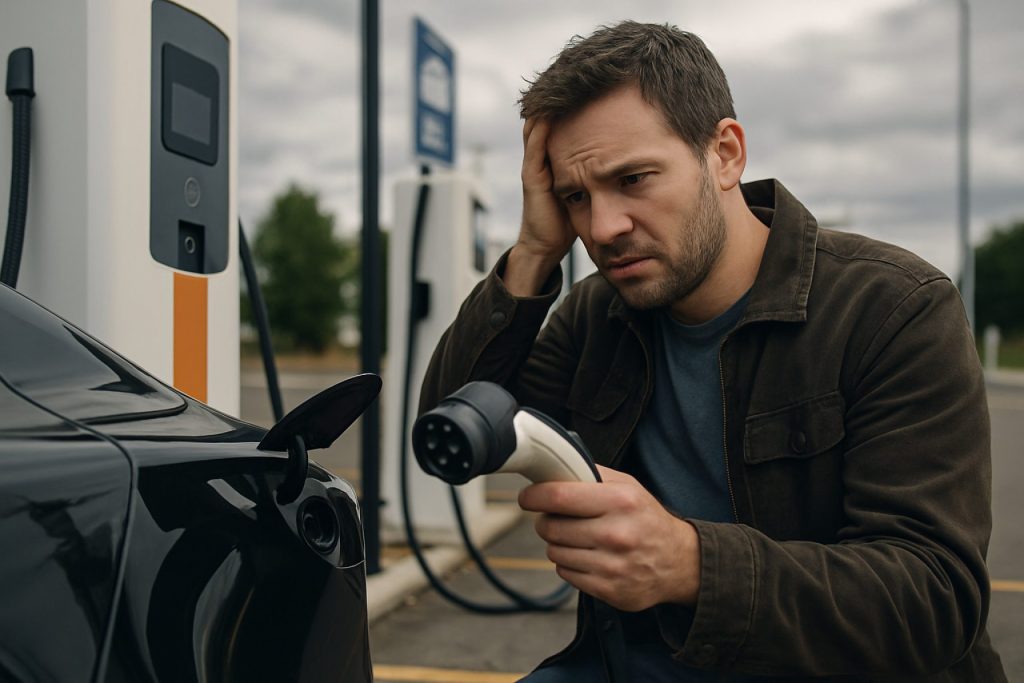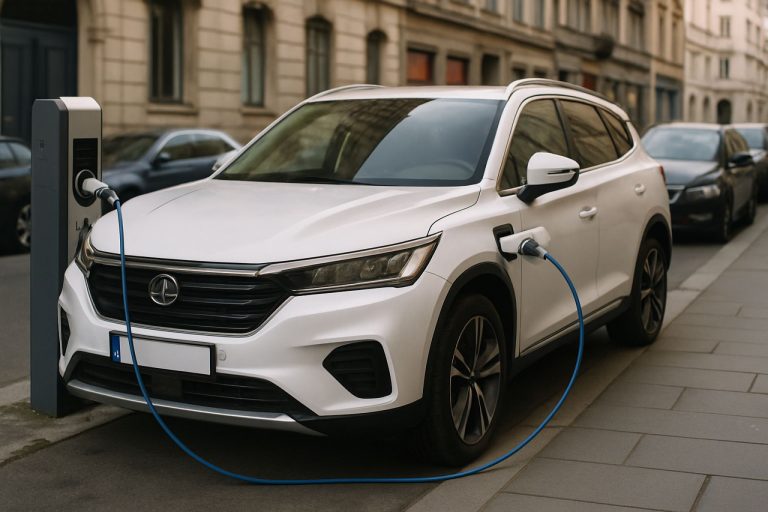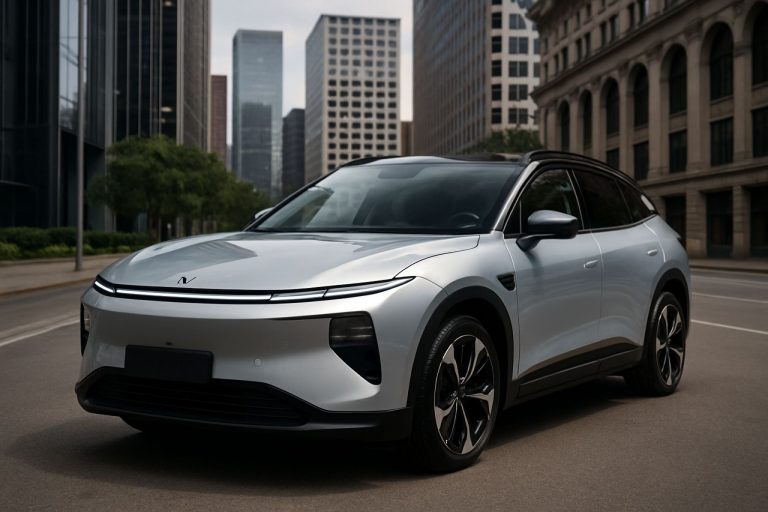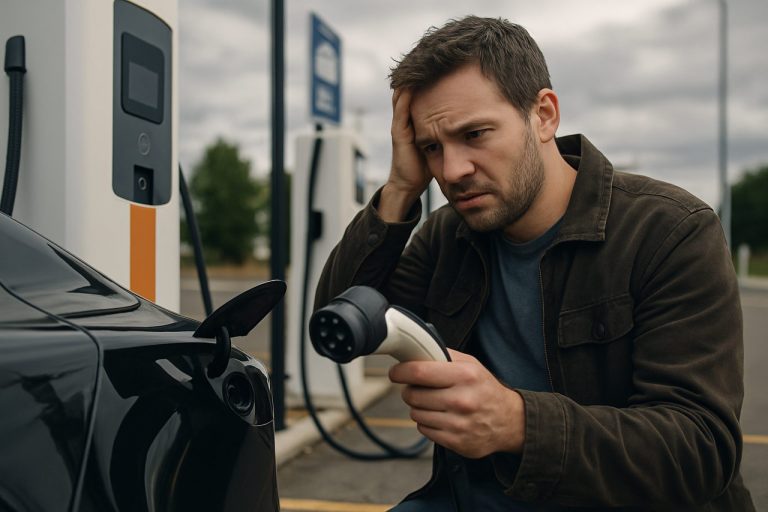
- America’s EV infrastructure is under strain, with public charging availability lagging behind surging electric vehicle adoption.
- There are about 160,000 public charging ports nationwide, but experts stress this number must triple to meet federal goals and mass EV use.
- Federal funding for new charging stations faces political hurdles, which could slow expansion and maintenance efforts.
- EV owners frequently encounter broken, outdated, or incompatible chargers, with up to 20% of charging attempts failing due to malfunctions.
- Urban areas face overcrowded chargers, while rural “charging deserts” present long distances between reliable stations.
- Robust investment and reliable charging infrastructure are essential to overcoming range anxiety and ensuring successful EV adoption.
Arctic mornings in Minnesota or sunbaked afternoons in Arizona, the promise of electric vehicles—silent, clean, the future—seems unstoppable. Behind the wheel, the steady hum of an electric motor feels like progress itself. But imagine this: your battery dips to 6%, and the GPS blinks out the only fast charger for miles is full, broken, or simply gone. This isn’t a scene from a dystopian film; for a growing number of EV owners, it’s an emerging reality.
America’s charging grid is under serious strain. Recent months have seen a swell of electric vehicles on the road—over 3 million registered and counting. Automakers like Tesla, Ford, and General Motors have pumped unprecedented resources into electric lineups, eager to flood the country with zero-emission models. But while EV sales race forward, public charging infrastructure lags dangerously behind.
The numbers reveal the pinch: as of early 2024, there are around 160,000 public charging ports nationwide, according to the U.S. Department of Energy. However, experts warn that to support mass EV adoption and President Biden’s ambitious goal of 500,000 chargers by 2030, infrastructure needs to triple—fast.
Enter political turbulence. Recent debates in Congress threaten to stall crucial federal funding for new charging initiatives. Without sustained investment, states could struggle to maintain even current networks, let alone expand them. The North American Charging Standard (NACS), championed by Tesla, is helping unify tech, but rollouts remain uneven, patchy, and often prone to malfunctions or long lines.
Urban dwellers in places like Los Angeles and New York navigate a patchwork of broken Level 2 ports and overcrowded quick-charge stations. Rural commuters face vast “charging deserts”—hundreds of miles between reliable plugs, daunting for anything beyond city limits. Even middle America’s robust highway rest stops, symbols of national connectivity, can’t yet promise a spot for every plug-in traveler.
Complicating matters, many existing chargers are old, under-maintained, or incompatible with newer vehicle models. Recent J.D. Power studies show that one in five charging attempts fail due to damaged or offline stations. Industry leaders stress that without coordinated investment and aggressive maintenance, these failures may worsen.
Why does this matter? The great electric transition hinges not just on what we drive, but on where—and how—we fuel up. Clean energy experts at the International Energy Agency emphasize that reliable, visible charging networks are essential to squashing “range anxiety,” the number one reason many Americans still hesitate to ditch gasoline.
The key takeaway? The future of electric mobility in America—its convenience, accessibility, and appeal—rests on infrastructure as much as innovation. If the country falls short, it won’t just slow climate goals; it could strand millions in a new technological limbo, stuck in the gap between vision and reality.
For now, if you’re eyeing an EV—or already own one—know your charging landscape. Plan routes. Watch legislative debates. And, perhaps most crucially, push policymakers and industry giants to treat infrastructure as the true backbone of cleaner, greener transportation.
Transitioning to electric won’t just depend on cutting-edge cars. The places we charge, and the power behind them, will determine who gets to drive the future.
For more information on electric vehicles and infrastructure, check out energy.gov and Tesla.
Electric Cars Stuck in the Slow Lane? Hidden Truths About America’s Charging Crisis
—
# EV Charging Infrastructure Crisis: Key Facts, Trends & Life Hacks Every Driver Should Know
America’s growing love affair with electric vehicles (EVs) has sparked a revolution—but it’s not all smooth driving. Beyond the beautiful motor hum and eco-friendly promise, drivers are hitting real-world roadblocks that the headlines don’t always reveal. Here’s what’s missing, what you must know, and how to stay ahead in the race toward electrification.
—
Additional Facts & Insights: What’s Really Happening?
1. Stubborn Reliability Issues
– High Failure Rates: According to J.D. Power’s 2023 study, roughly 21% of public charging attempts fail, primarily due to inoperable stations, payment glitches, or software issues.
– Aging Infrastructure: Many charging stations installed early in the last decade are aging out, lacking both parts availability and modern communication protocols.
– Vandalism and Weather: Chargers can be targeted by vandalism, and in areas like Minnesota, cold snaps hinder charger performance and screen usability.
2. EV Charging Levels and Compatibility
– Level 1: Standard wall outlets (120V)—only suitable for overnight home charging (adds 2-5 miles of range per hour).
– Level 2: Dedicated 240V home/public units—quicker, with 10-25 miles per hour.
– DC Fast Charging: Adds up to 200+ miles of range per hour, but fast chargers are less than 20% of all public stations.
– Plug Standards: North American Charging Standard (NACS—championed by Tesla) is gaining ground, with Ford, GM, and others planning adoption in 2024-2025, but the transition remains uneven ([source](https://www.energy.gov)).
3. Urban vs. Rural Gaps
– Urban Overcrowding: Cities see longer queues and more frequent charger breakdowns, especially in multi-unit dwellings lacking private parking.
– Rural “Charging Deserts”: Areas across the Midwest, Mountain West, and South can have over 50-mile gaps between fast chargers.
4. Federal and State Incentives
– Up to $7.5 Billion Allocated: The 2021 Bipartisan Infrastructure Law includes multi-billion-dollar investments specifically for charging infrastructure—but disbursement is slow due to permitting and local politics.
– State-Level Grants & Utility Programs: Some utilities offer rebates for home charger installation, but coverage varies widely by state.
5. Market Forecasts & Industry Trends
– Charger Count Must Triple: The International Council on Clean Transportation estimates the U.S. will need about 495,000 public charging ports by 2030.
– Private Sector Surge: Companies like ChargePoint, Electrify America, and Tesla are racing to build, but harmonization and dependability lag behind EV sales.
—
Reviews, Comparisons & Real-World Use Cases
Top Public Charging Networks (2024):
| Provider | Pricing (per kWh or min) | Coverage | Reliability (J.D. Power) |
|———————-|————————–|—————|————————-|
| Tesla Supercharger | $0.25-$0.50/kWh | Extensive, but Tesla-only (opening to others) | 95% |
| Electrify America | $0.43-$0.50/kWh OR $4/min| Nationwide | 82% |
| ChargePoint | Varies—site owner sets price| Nationwide | 80% |
| EVgo | $0.34-$0.49 per min OR $0.27-$0.35/kWh | Metropolitan-focused | 83% |
Real-World Use Cases:
– Apartment Dwellers: Face limited charging options; some resorts to running extension cords or using slow, unreliable Level 2 stations.
– Long Haul Drivers: Must plan trips meticulously with apps like PlugShare due to inconsistent fast charger availability.
– Ride-Share Drivers: Frequent charging downtime cuts into earnings.
—
Controversies & Limitations
– Equity Issues: Affluent neighborhoods and highways receive more investment; low-income, rural, or minority communities remain underserved.
– Maintenance Responsibility: Often unclear—leading to dead or vandalized stations lingering offline for months.
– Peak Power Draw: Fast chargers can strain local grids, especially during summer or winter surges.
—
Security, Sustainability & Future-Proofing
Security:
– Data Privacy: Public chargers may collect driver and payment information—look for PCI-compliant networks.
– Charger Tampering: Some cities are addressing physical and cybersecurity risks amid increased vandalism.
Sustainability:
– Green Energy Sources: Not all charging stations use renewable energy; some rely on coal or gas-driven grids depending on state policy.
– Battery Lifecycle: The U.S. lacks full-scale recycling infrastructure for spent EV batteries—an emerging environmental concern.
—
How-To & Life Hacks: Make The Most of the Current Charging Landscape
How-To: Find Reliable Chargers
1. Use Apps: Try PlugShare, ChargeHub, or the network’s own apps for real-time data on charger status.
2. Call Ahead: When possible, call the listed site host to verify operation.
3. Carry Adapters: Especially as standards change, carry both CCS and NACS adapters if your vehicle allows.
Quick Tips:
– Never Drop Below 20%: Especially outside urban areas, for safety and flexibility.
– Avoid Rush Hours: Early morning or late evening sees fewer queues.
– Monitor Legislation: Keep an eye on debates that may impact funding or charger rollouts—contact your legislators with your concerns.
—
Most Pressing Questions—Answered
Q: When will coverage improve for rural and underserved areas?
A: The federal goal is 500,000 chargers by 2030, with early emphasis on cross-country corridors, but reaching rural communities may lag until at least 2026, barring private sector breakthroughs or new funding.
Q: Are all chargers compatible with every EV?
A: No; while adoption of the NACS (Tesla plug) improves interoperability, many non-Tesla vehicles still depend on CCS or CHAdeMO in the meantime.
Q: What are the best options for home charging?
A: Level 2 home chargers are most efficient. Many states or utilities offer rebates—check with your provider or the Department of Energy at energy.gov.
Q: How can I get advance notice when a charger is offline?
A: Public platforms like PlugShare allow users to report outages and see recent activity in real time, though networks are working to improve automatic status updates.
—
Actionable Recommendations: What You Can Do Right Now
– Map Your Local Chargers: Even if you’re not yet an EV owner, get familiar with station locations, types, and user reviews.
– Push for Change: Email or call state and federal reps to support reliable, transparent infrastructure funding.
– Join the Community: Share real-time charging station reviews or outages through trusted apps—help others and crowdsource data for better experiences.
– Future-Proof Your Purchase: If buying an EV, prioritize models compatible with both CCS and NACS plugs until standards settle.
—
The Bottom Line
America’s electric revolution hangs in the balance—a race between rapidly advancing cars and a charging infrastructure gasping to keep pace. Staying informed, vocal, and adaptable is your superpower in the EV era. For more on energy and transportation policy, visit energy.gov and Tesla.
—
Keywords: EV charging, electric vehicle infrastructure, NACS, public charging stations, range anxiety, electric cars, US charging grid, Biden 500,000 chargers, charger compatibility, charging reliability, PlugShare, Electrify America, Tesla Supercharger, Level 2 chargers, CCS adapters, EV incentives.



